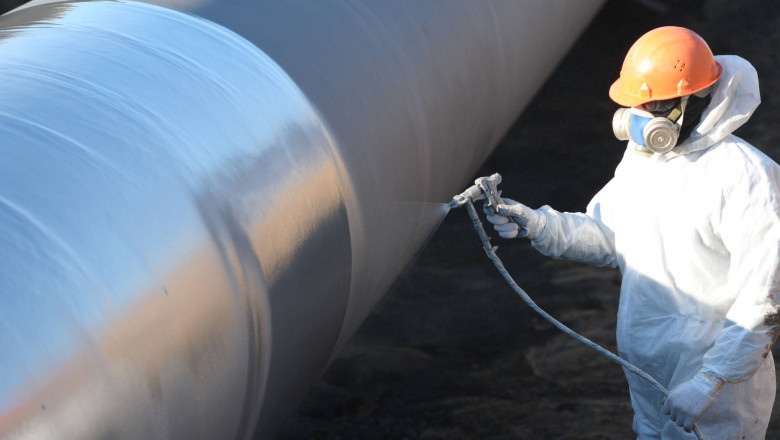views
Industrial Coating Market Intelligence: Innovations, Sustainability, and Regulatory Impact on Global Demand
Introduction
The industrial coating market is undergoing rapid transformations due to technological innovations, sustainability initiatives, and evolving regulatory frameworks. Industries across automotive, aerospace, construction, and manufacturing are increasingly adopting high-performance, low-VOC, and environmentally friendly coatings to enhance durability and meet compliance requirements. The integration of advanced materials, AI-driven solutions, and digital technologies is further shaping market growth, ensuring efficiency, cost-effectiveness, and sustainability.
This article delves into the latest innovations, sustainability efforts, and regulatory influences impacting the global demand for industrial coatings.
Innovations Driving the Industrial Coating Market
Technological advancements in industrial coatings are revolutionizing material properties, application methods, and overall performance. Key innovations include:
1. Nanotechnology-Enabled Coatings
Nanotechnology is enhancing industrial coatings by improving adhesion, corrosion resistance, and surface hardness. These coatings offer:
-
Self-cleaning properties, reducing maintenance costs in industrial and automotive applications.
-
Superior barrier protection against UV radiation, moisture, and chemicals.
-
Antimicrobial coatings that prevent bacterial growth in healthcare and food industries.
2. AI and Digitalization in Coating Technology
AI-driven solutions are transforming coating formulations, application processes, and quality control. AI enhances:
-
Predictive maintenance by detecting coating deterioration before failures occur.
-
Automated defect detection, ensuring consistent application and reducing production errors.
-
Smart coatings with responsive properties, adapting to environmental changes in real time.
3. Smart and Self-Healing Coatings
Emerging smart coatings are designed to adapt to various industrial conditions. Key developments include:
-
Self-healing microcapsules that release protective agents when coating damage occurs.
-
Conductive coatings that prevent static buildup and improve electrical conductivity.
-
Thermochromic and photochromic coatings that change properties based on temperature or light exposure.
4. Waterborne and Powder Coatings
The transition from solvent-based coatings to waterborne and powder coatings is driven by sustainability and environmental concerns. Benefits include:
-
Lower VOC emissions, reducing health hazards and regulatory compliance challenges.
-
Enhanced durability and performance, with resistance to corrosion and harsh environments.
-
Cost-effective and energy-efficient application processes, reducing operational expenses.
Sustainability Initiatives in the Industrial Coating Market
Sustainability is at the forefront of industrial coating advancements, with manufacturers investing in eco-friendly formulations, renewable raw materials, and circular economy practices.
1. Low-VOC and Bio-Based Coatings
Regulatory bodies worldwide are imposing strict limitations on volatile organic compound (VOC) emissions, encouraging manufacturers to develop:
-
Bio-based coatings derived from renewable plant oils and natural resins.
-
Low-VOC and solvent-free formulations, reducing air pollution and improving workplace safety.
-
High-solid coatings, minimizing solvent evaporation while maintaining high durability.
2. Recyclable and Sustainable Coating Solutions
With growing emphasis on the circular economy, industrial coatings are being designed for recyclability and reduced waste. Innovations include:
-
Coatings with biodegradable components, breaking down naturally without harming the environment.
-
Recyclable powder coatings, allowing for material recovery and reuse in industrial processes.
-
Durable coatings that extend equipment life, reducing the need for frequent recoating and material consumption.
3. Energy-Efficient Curing Technologies
To lower the carbon footprint of coating applications, manufacturers are adopting energy-efficient technologies, such as:
-
UV-curable coatings, which require less energy and reduce drying times.
-
Infrared curing processes, ensuring faster and uniform coating hardening.
-
Low-temperature curing coatings, minimizing energy usage in industrial settings.
Regulatory Impact on the Global Industrial Coating Market
Regulations play a crucial role in shaping the industrial coating industry, ensuring product safety, environmental compliance, and worker protection. Major regulatory influences include:
1. Stricter VOC and Emission Regulations
Governments worldwide are implementing stringent VOC emission limits to reduce air pollution. Key regulations include:
-
EU REACH (Registration, Evaluation, Authorization, and Restriction of Chemicals), enforcing strict chemical safety standards.
-
U.S. Environmental Protection Agency (EPA) Clean Air Act, limiting VOC levels in industrial coatings.
-
China’s Environmental Protection Law, driving the adoption of waterborne and low-VOC coatings.
2. Occupational Safety Standards
Worker safety regulations are influencing the development of non-toxic, low-hazard industrial coatings. Compliance with:
-
OSHA (Occupational Safety and Health Administration) standards, reducing exposure to harmful chemicals.
-
ISO 14001 environmental management standards, ensuring sustainable coating production and application processes.
-
GHS (Globally Harmonized System) labeling requirements, improving chemical hazard communication in industrial settings.
3. Sustainability and Green Building Certifications
Sustainability regulations are promoting eco-friendly coatings in the construction and infrastructure sector. Certifications include:
-
LEED (Leadership in Energy and Environmental Design), encouraging low-VOC and energy-efficient coatings.
-
BREEAM (Building Research Establishment Environmental Assessment Method), supporting sustainable construction materials.
-
ENERGY STAR certification, recognizing coatings that improve energy efficiency in buildings and industrial facilities.
Market Growth and Future Outlook
The global industrial coating market is expected to witness steady growth due to increasing demand from key industries, technological advancements, and regulatory compliance. Future trends include:
-
Expansion of smart coatings and AI-driven solutions, improving efficiency and predictive maintenance.
-
Growing demand for corrosion-resistant coatings in renewable energy and offshore industries.
-
Increased investment in nanotechnology, offering enhanced material performance and longevity.
-
Further development of bio-based and low-VOC coatings, supporting environmental sustainability goals.
-
Integration of digitalization in coating manufacturing, enhancing process automation and data-driven insights.
Conclusion
The industrial coating market is evolving with innovations in material science, AI integration, and sustainability initiatives. As industries seek high-performance, environmentally friendly coatings, manufacturers are focusing on low-VOC, smart, and energy-efficient solutions to meet global demand. Regulatory frameworks continue to drive the industry towards safer, more sustainable, and high-quality coatings, ensuring long-term market growth and environmental responsibility. With continuous advancements, the industrial coating sector is set to thrive in an era of technological transformation and sustainability-driven innovation.






















Comments
0 comment